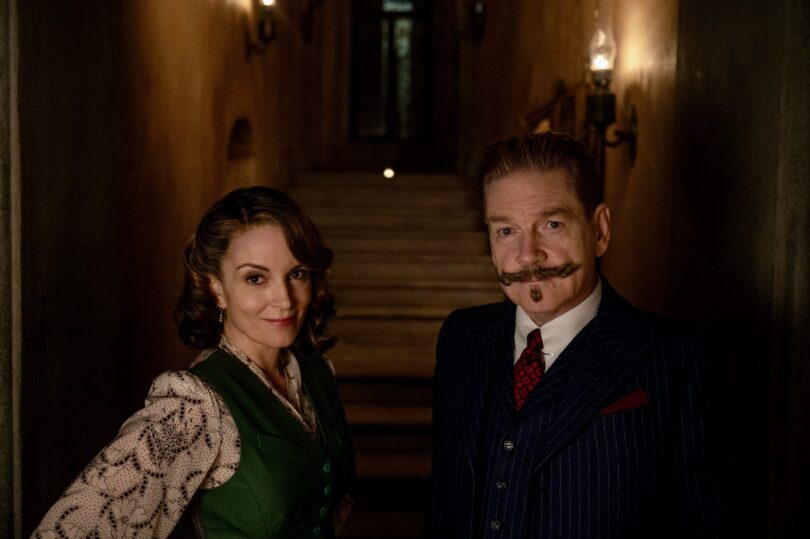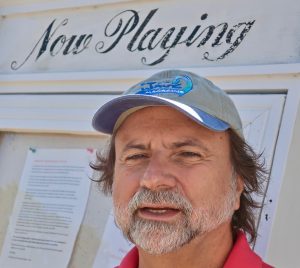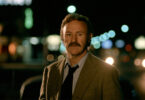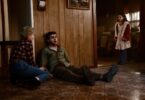“A Haunting in Venice” (PG-13, 103 minutes, in theaters) won’t leave you quivering in your shoes.
And that’s a shame.
Even though the film based on a mystery novel by Agatha Christie – whose detective fiction is more concerned with the solving of murder cases than conjuring up horror – director (and star) Kenneth Branagh certainly aims for delivering chills, whether through his tilted camera shots (always a clue that something is horribly off-kilter), the spooky set design and costumes, or the occasional jump-scares.
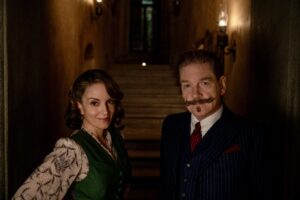
Master detective Hercule Poirot (Kenneth Branagh) joins mystery writer Ariadne Oliver (Tina Fey) at a seance in “A Haunting in Venice.” (20th Century Studios)
If only all of this added up to something more scary. “A Haunting in Venice” is atmospheric enough – and entertaining enough – to make for an appealing Halloween-season diversion, but one walks away from it wishing it provided more. More jolts. More surprising twists. More dramatic weight.
Branagh plays Christie detective extraordinaire Hercule Poirot. It’s his third go-round playing the Belgian with the prominent mustache (almost a character in itself), following his work in Christie adaptations “Murder on the Orient Express” and “Death on the Nile.”
It’s 1947 – two years after World War II, for you non-history buffs – in, as you might have guessed from the title, Venice (Italy, not California). The war has left Poirot disillusioned with life and humanity, and convinced there is no God. He’s given up detecting and has retreated into seclusion, despite persistent calls for his expertise.
Along comes his mystery-writer acquaintance Ariadne Oliver (Tina Fey!), who invites him to attend a seance with her at an old, dark palazzo on Halloween (as if a seance alone wouldn’t be creepy enough). The palazzo’s owner, opera singer Rowena Drake (Kelly O’Reilly), has hired famed medium Joyce Reynolds (recent Oscar winner Michelle Yeoh) to contact the spirit of Drake’s daughter, a possible suicide.
Poirot reluctantly accepts the invitation, and the challenge of exposing the medium as a fake. Instead – surprise! – he finds himself in the middle of a complex murder mystery, with multiple suspects, many of whom have intersecting secrets that Poirot strips away, one by one. Meanwhile, our skeptical hero himself starts having visions. (What … the … heck?)
Branagh, as the flamboyant sleuth, and Yeoh, as the seemingly sinister psychic, stand out among the large cast, and it’s good to see Fey take on a role more dramatic than usual.
But, unlike the best Christie film adaptations – Billy Wilder’s “Witness for the Prosecution,” Rene Clair’s “And Then There Were None” – “A Haunting in Venice” lacks a wow factor, a final knockout twist. It’s fun; like Poirot, it gets the job done. But it’s nothing special. *** (out of four)
She works hard for the money
Is it ever OK for a journalist to lie to get a story?
Do the ends ever justify the means?
These are not new questions. Nellie Bly pretended she was insane while going undercover in the 1880s to investigate the conditions and treatment of patients at a women’s asylum in New York. The horrors she reported on led to reforms. It didn’t hurt her career, either.
“Between Two Worlds” (106 minutes, available to rent or buy through streaming services) – based on a true story detailed in French author Florence Aubenas’ “La Quai de Ouistreham” – involves a French journalist who poses first as unemployed and desperate and then becomes a cleaning woman working a grueling job for minimum wage. Her goal: to uncover the true story behind those struggling with economic hardship.

Juliette Binoche, right, appears with Helene Lambert, left, and Lea Carne in “Between Two Worlds.” (Cohen Media Group)
Juliette Binoche plays the writer, Marianne Winckler, and she’s captivating, as always. Binoche performs the neat trick of convincing us that Marianne is different enough from her fellow workers to arouse a bit of suspicion about her but believable enough to make them accept her as one of their own.
That said, Helene Lambert, in her feature-film debut, steals the film as Chrystele, a proud, angry, streetwise young cleaning woman who shows Marianne the ropes and is confused by her new friend’s stop-and-smell-the-roses approach to life. She wonders who has the time when you’re just trying to survive?
Directed by Emmanuel Carrere (“The Moustache”), the film purposely leaves us to consider a few questions:
Is going undercover this way to get a story ethical if it’s done for the “right” reasons? Who decides what the right reasons are? Where do you draw the line?
Are Winckler’s friendships with Chrystele and others real if the journalist is lying to them while posing as someone other than herself? Is this possible?
The film goes further: Is it possible, really, for a successful writer like Marianne to be friends with cleaning women like Chrystele and others – or do the economic divisions in society (whether in France or anywhere) make this impossible?
The film in many ways is at its best in showing what Marianne hopes to reveal: what it’s like to have to struggle to get a job, or work a demanding job for a substandard wage. It shows the dignity that comes with working hard, working under pressure, whether it’s scrubbing toilets or some other job that some might consider demeaning. And it shows the camaraderie among people who work such jobs, the bonds that form when people go through a kind of hell together.
“Between Two Worlds” leaves a lot in question, but one thing it makes clear. That connection that comes from shared struggle? That’s real. ***½
** Click here for Tim Miller’s previous movie columns for Cape Cod Wave **
Please like Cape Cod Wave on Facebook.
Cape Cod Wave Magazine covers the character & culture of Cape Cod. Please see our Longform stories.
Tim Miller is co-president of the Boston Society of Film Critics. He teaches film and journalism at Cape Cod Community College in West Barnstable. You can contact Tim at [email protected] or follow him onTwitter @TimMillerCritic. Or you can ignore him completely.

